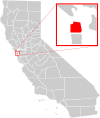St. Francis Wood
History
St. Francis Wood was established in 1912 as a neighborhood for upper-middle class residents with convenient streetcar access to jobs downtown. The residence park was inspired by the City Beautiful movement. The neighborhood's street layout was designed by the Olmsted Brothers and characterized by "standalone houses, curvilinear streets, extensive landscaping and decorative monuments" that evoked the feeling of living in a park. Like other residence parks, the neighborhood used racial covenants to block Black and Asian people from moving in. The neighborhood was an early adopter of zoning restrictions, including single-family zoning to ban apartment buildings and commercial development, because they were thought to attract racial minorities.
Historic Designation
On June 30, 2022, St. Francis Wood was added to the National Register of Historic Places after a yearslong campaign by residents who quoted its architectural history as a residence park. The historic designation will require all construction projects in the neighborhood to undertake a review under the California Environmental Quality Act, adding about $10,000 in fees and 4 months in project approvals. The historic designation will also require new projects to be compatible with the neighborhood's historic character, which is typically two-story single family homes with large yards.
The designation was criticized by YIMBY activists who said that the historic designation would make it much harder for people to add housing to the neighborhood, and cement the neighborhood's status as a wealthy neighborhood that excludes Black and Latino people. Places with historic resources are often exempted from state bills that encourage the construction of new homes. State Senator Scott Wiener expressed concern that St. Francis Wood's historic designation creates a model for other wealthy neighborhoods to evade the intent of state housing law to build more homes in all neighborhoods.
The St. Francis Homes Association said that the historic designation was about the architectural history and said that they were an inclusive community open to the public. St. Francis Wood's amenities are not open to the public.
Demographics
| Race and Ethnicity | |||
|---|---|---|---|
| Asian | 730 | (45.3%) | |
| White Non-Hispanic | 726 | (45%) | |
| Hispanic (excluding Black and Asian) | 87 | (5.4%) | |
| Other Non-Hispanic | 48 | (2.98%) | |
| Mixed Non-Hispanic | 17 | (1.05%) | |
| Black | 4 | (0.248%) | |
| Source: https://statisticalatlas.com/neighborhood/California/San-Francisco/St-Francis-Wood/Race-and-Ethnicity#top | |||
In the two 2020 census tracts that contain St. Francis Wood 2020 census, at least 80% of the residents are White or Asian. The median household income is $188,400.
References
- ^ "St. Francis Wood Demographics and Statistics on Niche".
- ^ "Saint Francis Wood neighborhood in San Francisco, California (CA), 94127 detailed profile". City-Data.com. Urban Mapping, Inc. Retrieved 9 March 2013.
- ^ "Researching Residence Parks". SF West History. 10 (4). Oct–Dec 2014.
- ^ Echeverria, Danielle (2022-04-29). "This wealthy S.F. neighborhood is seeking historic status. YIMBYs say it's an effort to block housing — and point to racist past". San Francisco Chronicle. Retrieved 2022-07-15.
- ^ Schneider, Benjamin (2022-07-14). "St. Francis Wood earns historic designation, sparks backlash". San Francisco Examiner. Retrieved 2022-07-15.
- ^ "Parks | St. Francis Wood". St. Francis Wood. St. Francis Homes Association. Retrieved 2022-07-31.
- ^ "The Demographic Statistical Atlas of the United States - Statistical Atlas". statisticalatlas.com. Retrieved 2022-07-15.
External links
 Media related to St. Francis Wood Historic District at Wikimedia Commons
Media related to St. Francis Wood Historic District at Wikimedia Commons
- History of St. Francis Wood, St. Francis Homes Association
- Traffic solution for St. Francis Circle
